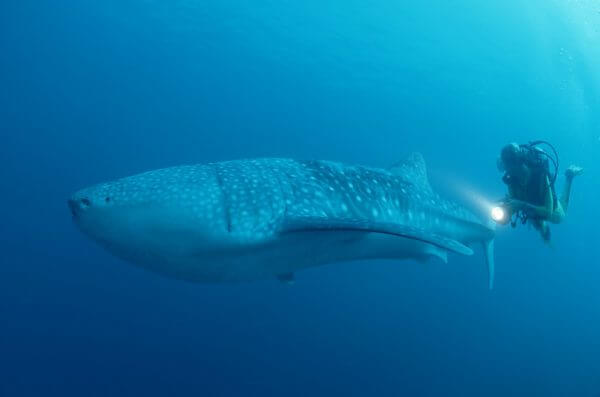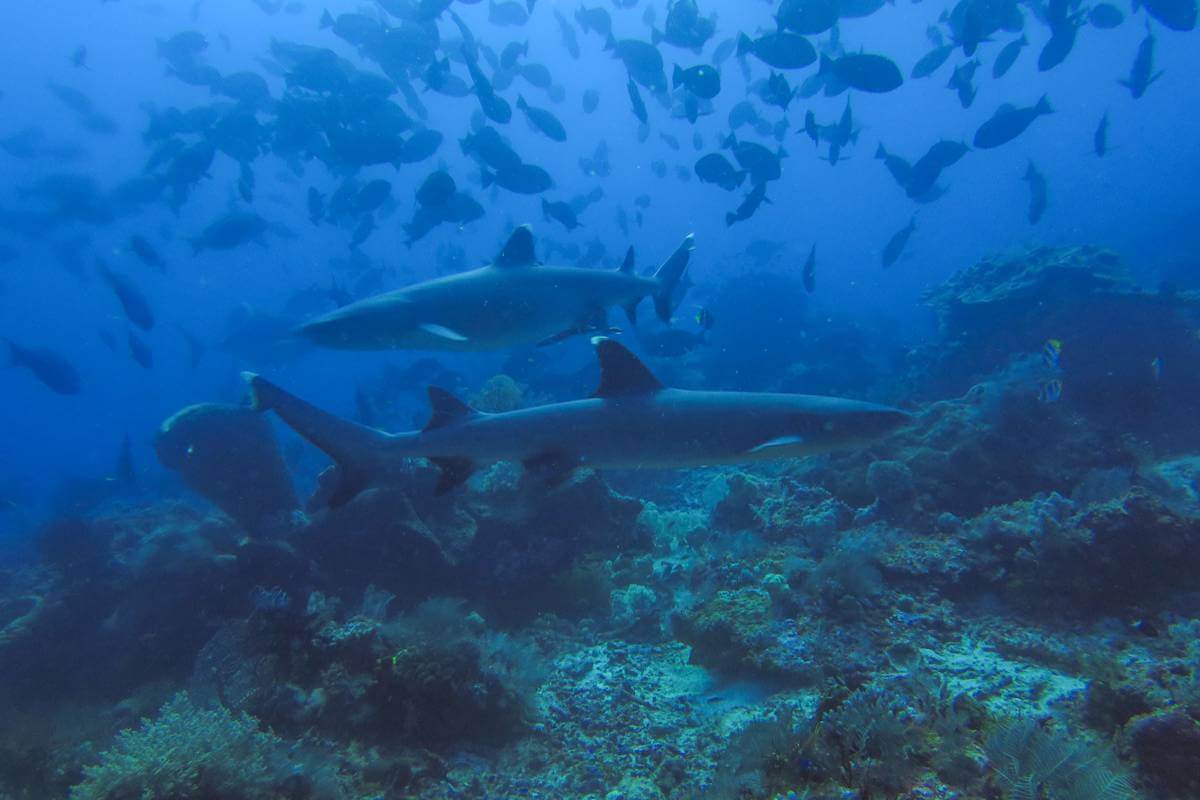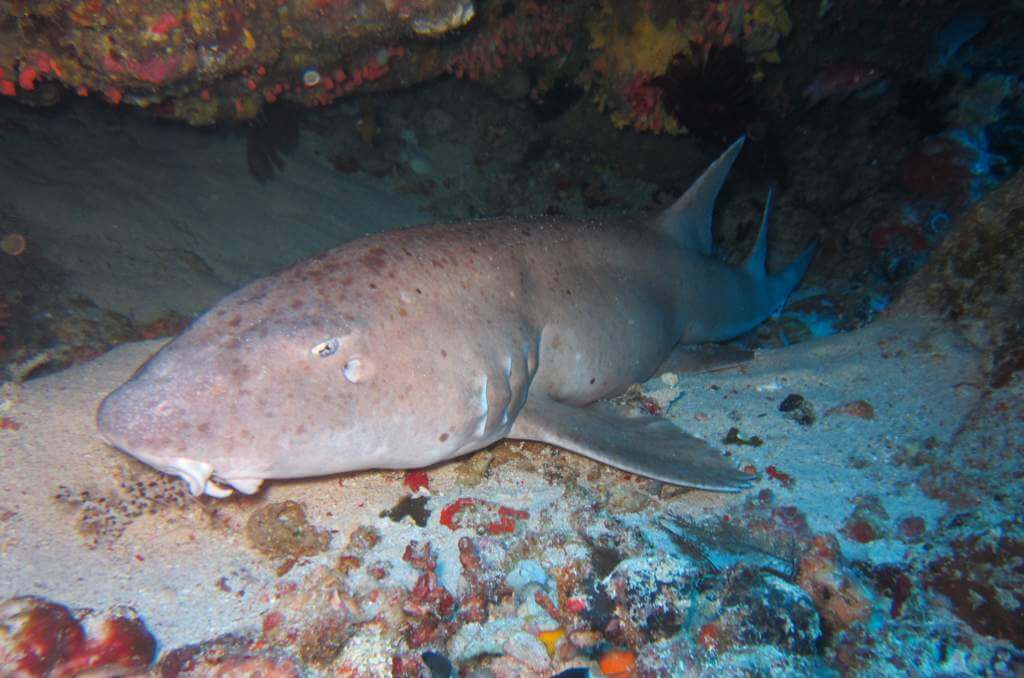What types of sharks can you hope to see in the Komodo National Park? With over 500 shark species in the world, one’s list of diving destinations must spread far and wide in order to see them all. So how many can be ticked off the long list by scuba diving in this stunning location?
White Tip Reef Shark (Triaenodon Obesus)

- Max sixe: 1.6 m
- IUCN status: Near Threatened
- Reproduction: viviparous gestation period of 10-13 months for 1 to 6 live pups every other year
One of the most common sharks found on Indo-Pacific reefs, the “white tips” are best spotted in the Park around the sites around Gili Lawa Laut. Babies can usually be found hiding underneath table corals at Castle Rock, Tengah and Siaba Besar. Fun fact: they are one of the few shark species that can pump water over their gills and lie still on the bottom.
Black Tip Reef Shark (Carcharhinus Melanopterus)
- Max size: 1.6 m
- IUCN status: Near Threatened
- Reproduction: viviparous gestation period ranges from 7–9, through 10–11, to possibly 16 months for 2-5 live pups on a biennial, annual, or possibly biannual cycle
This timid shark is difficult to approach but roams throughout the National Park. Some of the best sites to grasp a glimpse of the black tip reef sharks in Komodo are Karang Makassar, The Passage and Tengah.
Grey Reef Shark (Carcharhinus Amblyrhynchos)
- Max size: 1.9 m
- IUCN status: Near Threatened
- Reproduction: viviparous gestation of about a year for 1-6 pups every other year
The biggest sharks commonly seen in Komodo mainly patrol the dive sites of Castle Rock and Crystal Rock but have made quick appearances at a few other locations.
- Crystal Rock, Komodo National Park
Brown-Banded Bamboo Shark (Chiloscyllium Punctatum)
- Max size: 1.2 m
- IUCN status: Near Threatened
- Reproduction: oviparous
Giving birth to the cutest “black and white” pups, these nocturnal sharks can be found in the daytime hiding underneath coral formations. They have more rarely been seen swimming in the open at Karang Makassar, Mauan and Tatawa Besar. Pups have been spotted on night dives at Siaba Besar. This species can rest on the bottom.
Coral Cat Shark (Atelomycterus Marmoratus)
- Max size: 70 cm
- IUCN status: Near Threatened
- Reproduction: oviparous
Writing down this shark in your logbook on a Komodo trip is a score! These timid small sharks are rarely seen but, if they are, it is usually in the southern end of the Park such as on 3 Sisters. To increase your chances of seeing one, join one of the special Adelaar cruises, which focus on the South of Komodo.
Tawny Nurse Shark (Nebrius Ferrugineus)
- Max size: 3.2 m
- IUCN status: Vulnerable
- Reproduction: aplacental viviparous meaning that the embryos hatch inside the mother and eat each other
Nurse sharks have seldomly been spotted in the southern part of the Komodo National Park at sites such as Fish Market where they usually rest in small holes or on the bottom until night time. As their similar looking cousin the bamboo and other epaulette sharks, nurse sharks can also rest on the bottom.
Whale Shark (Rhincodon Typus)
- Max size: 12.65 m
- IUCN status: Endangered
- Reproduction: ovoviparous for up to 300 pups that get born over an extended period of time
Harmless to humans due to its strict plankton diet, the whale shark is considered a gentle giant and easily approachable when on the surface. As they only reach maturity at 30 years of age, they are listed as endangered. Anyone with a camera can contribute to whale shark conservation by uploading photos or videos of encounters to the Wildbook. Although spotting a whale shark in Komodo is more of a lucky encounter, the Adelaar has partnered with scientists on a few special trips a year to swim and dive with these wonderful creatures. Find these cruises on our schedule and rates page and grab a spot before they are sold out!
“Bonus Sharks”
The Komodo National Park is full of surprises and there are often unexpected sightings! We have had unsettled endless debates on the Adelaar to determine which species of shark was that shadow in the distance. There have also been reports of hammerheads passing by, a young tiger shark eating a dead whale at the surface and, in 2017, a megamouth shark was spotted at a famous dive site in the north of Komodo island. If the diver hadn’t recorded this video as proof, we may have never believed it! See this shark in action.
Conservation Issues
Sharks have been around for over hundreds of millions of years. Despite their fearsome reputation, sharks are most likely to be killed by humans than the other way around. Scuba divers know that the number of these apex predators is rapidly declining due mostly to shark fin soup, and, to a lesser known extent, fish/shark oil supplements, for example. Sharks grow relatively slowly, take many years to mature and produce relatively few young for most of the species. Their reproductive rate makes them incredibly vulnerable to the speed at which they are being hunted and killed. Some species are on the brink of extinction. As sharks are apex predators keeping the oceans healthy, losing them would be an ecological disaster.
Although it only included the islands at first, the Komodo National Park was created in 1980. As stated in the above list, plenty of sharks can be spotted on a diving trip to Komodo. However, when interrogated on the matter, the pioneers often say that there are less sharks nowadays. Sadly, poachers regularly come into the Park with long lines for an easy prized catch. This is therefore a global issue and no shark is truly safe.
What Can You Do?
- There are plenty of organizations to donate to. Conservation International is a great global association doing hands on work with the local people as well as wide awareness campaigns. We also like Shark Guardian’s approach of educating the young generations in schools amongst other actions. Do some research and choose yours and sponsor an association in an area that matters to you most.
- Snorkel or scuba dive in famous locations for sharks. If tourism is boosting the economy, the government benefits from protecting the waters by creating marine parks and enforcing stricter fishing practices.
- Don’t eat at restaurants that serve shark fin soups and tell the manager why you choose not to have a meal there, even if there are plenty of other options.
- Teach friends and children about the puppy temperament of sharks and the threats they are facing. Creating educated new advocates can only benefit sharks in the future!
Written by Laura, lover of all things water, passionate diver and ocean advocate





